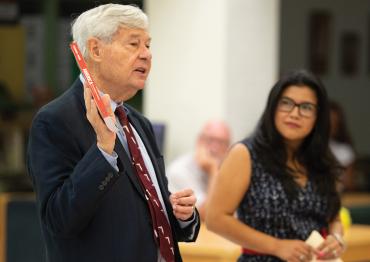I am a former U.S. senator, Florida governor, and member of both houses of the Florida Legislature. In my campaigns for governor and the U.S. Senate, and while serving in those offices, I was known for working full days in a variety of occupations, including as a factory worker, busboy, fisherman, and ironworker—in total, 408 workdays over a 30-year span. One job—my very first job—certainly stands out, however, and shaped much of my later work. It was 44 years ago, when I spent a semester teaching civics at Miami Carol City Senior High School.
Before working in the classroom, I was the head of the Florida state Senate’s Education Committee, and I was surprised by how little students understood about their local government institutions and how to influence change. I observed the decline in the teaching of civics, and how the curriculum placed too much emphasis on teaching about government, with too little attention to civic engagement. If students are not engaged, I found, they too often become cynical and divorced from community life, as well as the activities of a democratic society.
While bringing these concerns to a gathering of civics teachers, I was challenged to stop preaching, come into the classroom, and learn the reality teachers faced—indifferent students, parents who would not attend parent-teacher nights, an overly bureaucratic school administration, and all those laws politicians placed on teachers. I accepted this challenge for what became a semester-long transformational experience.
With the help of my students and Donnell Morris, a young social science teacher at Carol City High School, I developed a citizen-centric civics curriculum constructed around the essential skills of effective citizenship and hands-on projects applying those skills. Our goals were to tackle real issues that students were concerned with in their school and community. Students would learn ways to advocate for real change—this was not a simulation, but an exercise in advocacy. We wanted to teach students how to make government work for them.
Three decades later, after three terms in the U.S. Senate, I—as a senior fellow at the John F. Kennedy School of Government at Harvard University—led a class of Harvard undergraduates in an updated version of the Carol City High School curriculum. I then used these ideas last year as the basis for a new book (coauthored with my former Senate speechwriter Chris Hand), America, the Owner’s Manual: You Can Fight City Hall—and Win, which encourages strong civics education and participation.*
I’m honored that the United Teachers of Dade (UTD) Teaching Excellence Foundation has converted my book into a curriculum guide, combining it with professional development taught in part by me. More than 100 Miami-Dade teachers were trained in a series of union-sponsored professional development sessions this past school year, and my ideas on civic engagement are now being piloted in middle and high school civics classrooms across the county. This would not have been possible without the strong support of UTD President Karla Hernandez-Mats and her team at the union. It’s my hope that next school year, we will be able to expand the program piloted by UTD’s foundation to other school districts across the nation.
*To learn more about my ideas and review case studies of everyday Americans who have developed the skills to make changes in government policies, read America, the Owner’s Manual: You Can Fight City Hall—and Win, published by CQ Press. (back to the article)

